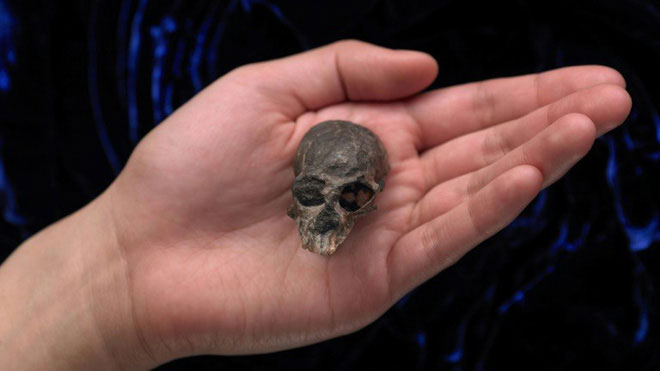The strange skull of ancient apes reveals the secret of how the primates' brains grow
In a study published in late August in the journal Science Advances, researchers in China and the United States used high-resolution images to examine the only known fossil skull. of the extinct Chilecebus - a new world monkey that roams the ancient mountain forest, eating its leaves and fruits.
Scientists have long thought that the primates 'brain size is always translating, growing over time, but this fact shows that the size of the primates' brains grows through winding steps. and independence in evolution.
Primate species are divided into two groups: Former world monkeys living in Africa and Asia; New world monkeys live in South America and Oceania.

A special fossil skull of Chilecebus carrascoenis, a 20 million year old primate from the Andes mountains of Chile.
Research co-author John Flynn of the American Museum of Natural History told AFP: "We found that in the main evolutionary branch, the majority of them tended to expand the skull and increase the size of the brain. but while there are certain groups going in the opposite direction, their brains tend to decrease in size. "
The study, led by Ni Xijun at the Chinese Academy of Sciences, used computerized tomography (CT) and X-ray scans on the inner part of the extinct Chilecebus skull fossils to determine the structure. inside the skull.

Scientists have long thought that the primates 'brain size is always translating, growing over time, but this fact shows that the size of the primates' brains grows through winding steps. and independence in evolution.
Although the Chilecebus species is nearly the size of a modern Marmoset or Squirrel lion, the opposite of the monkeys, the Chilecebus brain has some grooves called folds, which show the complexity. more cognitive complexity, in other words, brain size is not always related to brain progress and development.
Moreover, in modern primates, the size of the visual and olfactory centers of the brain is inversely proportional, meaning that stronger visual development species often have inferior sense of smell and vice versa. again
But the researchers found that a small olfactory region in Chilecebus did not provide a stronger visual ability, meaning that in the evolution of primates, the visual and olfactory systems were not involved. as tight as the previous assumptions.

Reconstructed images of Chilecebus carrascoenis, they are about the size of a Marmoset or modern Tamarin lion monkey (they are only the size of an adult's hand).
According to JohnFlynn, scientists can use well preserved fossils to test hypotheses that scientists have always mistakenly believe are true.
"Thanks to the well preserved ancient fossil specimen at an altitude of 10,000 feet (3,000 m) on the Andes, we can better understand our evolutionary history, and we can test out fake ones. previous theories as well as being able to understand the complex evolution of the brain in primates. "
- New fossils show primates that have ancestors in Asia
- The way the primates' brains look
- Monkey skull fossils 20 million years ago have the potential to reveal the evolution of the human brain
- Recreate the most ancient primates of Earth
- Humans are originally from Asia?
- Detect strange skull
- Detecting skulls dating to 430,000 years old
- Detecting ancient crocodiles 11 meters long
- Primate animals also nest
- Neuronic brains are like our brains
- Big brain makes smarter but less muscular?
- Spot the 'werewolf' skull
 Discovered an ancient centipede fossil 99 million years old
Discovered an ancient centipede fossil 99 million years old Discovered bat-like dinosaurs in China
Discovered bat-like dinosaurs in China Discovered a 200-year-old bronze cannon of the coast
Discovered a 200-year-old bronze cannon of the coast Discover 305 million-year-old spider fossils
Discover 305 million-year-old spider fossils